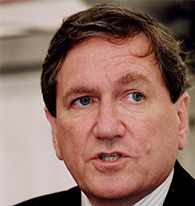
Berlin Views
By Richard Holbrooke
Even a New Yorker is struck by the raw, often-confusing, always impressive energy of the new Berlin. Whenever I return to Berlin, I am again struck by this. Yet, exciting as the capital’s new architecture and energy may be, the past is a relentless intruder, the engine that drives its current transformations.

Richard Holbrooke
To walk through Berlin is to enter a living version of a college survey course of 20th-century European history. One passes the parade grounds where Kaiser Wilhelm II, on his horse (and hiding his withered arm), reviewed the troops before World War I. The old Jewish quarter. The plaza on which Nazi students built a bonfire of “non-German” books in 1933. The Pariser Platz, where Hitler and Goebbels presided over torchlight parades and, in 1945, Soviet tanks smashed through the Brandenburg Gate. Hitler’s bunker, its actual location buried under new construction. The ruins of the Gestapo headquarters, saved from the wrecker’s ball and turned into a small museum, “The Topography of Terror.” The huge air terminal at Tempelhof, once Hitler’s pride and later the indispensable landing field through which the 1948 Airlift saved the city.
No city on earth has gone on such a rollercoaster ride in such a short span of time. There were the decades before Nazi rule: first, the years of pre-World War I innocence; then the Weimar era (still strangely innocent), immortalized in I Am a Camera and Cabaret. Then Hitler and the Holocaust. Berlin as the undisputed capital of evil.
Yet less than three years after the war’s end, the city’s Soviet liberators—by blockading it—transformed it into the ultimate symbol of the cold war, a city of heroic, freedom-loving survivors. Berlin went from villain to victim, from horrors to heroics, almost overnight. The decades that followed were high theater, and Berlin was often at center stage: the East German uprising of June 1953; JFK’s speech; Checkpoint Charlie; secret spy exchanges; Reagan’s visit; the night in November 1989 when the Wall came down; and, finally, in 1994—one last photograph for the history books—the Clintons and the Kohls walking side by side through the Brandenburg Gate into East Berlin, greeted by a crowd of more than one hundred thousand.
“Berlin is a city that never is, but is always in the process of becoming,” observed the noted German essayist Karl Scheffler in 1910. (He added, disapprovingly, that its people are “lured by the promise of Americanism.”) Ninety years later, Berlin is indeed becoming something new: Europe’s greatest showcase for modern architecture—although some Berliners, fulfilling their reputation for cynicism, like to say that the world’s best architects have come here to build their worst buildings. But even here, everything seems reflected through the past. Sir Norman Foster’s transparent high-tech dome sits atop the battle-scarred Reichstag and enables the visitor to literally (and symbolically) look down upon the German Parliament that has recently taken up residence there. Daniel Libeskind’s architectural tour de force, the Jewish Museum, bears within it an abiding reminder of the Holocaust’s ravages: an unavoidable and impenetrable void at the building’s center. A visit to the new home of the Ministry of Finance is especially bizarre, for it is housed in Göring’s massive Air Ministry, which survived every Allied attempt to destroy it during the war.
The battles over new and old architecture only underscore the dilemmas faced by contemporary Berlin. Every decision of the planning authority, every new building or monument, triggers an argument based on conflicting views of history. Should more of the Wall be preserved? Should war ruins be razed and paved over? How should the Holocaust be memorialized? Is the chancellor’s new office perhaps too grandiose—that is, is it too reminiscent of the quarters of a certain earlier German leader?
The Germans, who gave the word angst to the English language, worry constantly about how to deal with the heavy burden of their history. One of my friends—a prominent German politician—keeps in his study a portrait of his grandfather, which clearly shows his Nazi membership badge. “I could easily have had the badge painted over,” he told me, “but I felt I had to leave it in; for it is a historical truth. My grandfather thought Hitler would be good for Germany.”
“Berlin, Berlin, great city of misery,” wrote Heinrich Heine in the 19th century. “In you there is nothing to find but anguish and martyrdom.” Heine was prophetic, but I think Berlin’s years of excessive drama have finally come to an end. It is no longer a villain or a hero. Some Berliners may miss the exciting days when they were the center of the world’s worried attention. Some even miss the Wall, or at least some of the protection it afforded (and many still talk of a “wall in the head”—that is, of the different attitudes and expectations of Wessis and Ossis.) But in my view, this is not a time for nostalgia. Having worked closely with many members of a new generation of Germans, I have more confidence in them, perhaps, than they have yet to find in themselves.
With its overwhelming history Berlin will never be a “normal” city—even though it is no longer divided; even though American, British, French, and Soviet troops no longer face each other across a death zone; even though American presidents no longer fly to Berlin to reaffirm our commitment to freedom. But the ghosts will remain forever. As they should.
This text, published in the fall 2001 issue of the American Academy’s Berlin Journal, is based
on an article published in the September 10, 2001, edition of Newsweek International.
© 2001–2007 Carnegie Hall Corporation



